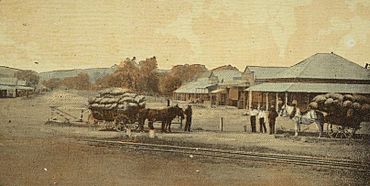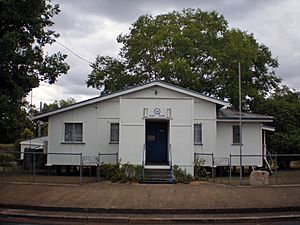Helidon, Queensland facts for kids
Quick facts for kids HelidonQueensland |
|||||||||||||||
|---|---|---|---|---|---|---|---|---|---|---|---|---|---|---|---|

Helidon, Queensland
|
|||||||||||||||
| Population | 1,130 (2021 census) | ||||||||||||||
| • Density | 23.16/km2 (60.0/sq mi) | ||||||||||||||
| Postcode(s) | 4344 | ||||||||||||||
| Area | 48.8 km2 (18.8 sq mi) | ||||||||||||||
| Time zone | AEST (UTC+10:00) | ||||||||||||||
| Location | |||||||||||||||
| LGA(s) | Lockyer Valley Region | ||||||||||||||
| County | Cavendish | ||||||||||||||
| Parish | Helidon | ||||||||||||||
| State electorate(s) | Lockyer | ||||||||||||||
| Federal Division(s) | Division of Wright | ||||||||||||||
|
|||||||||||||||
Helidon is a small town and area in the Lockyer Valley Region of Queensland, Australia. It's a rural place, meaning it's mostly countryside with farms and open spaces. In 2021, about 1,130 people lived in Helidon.
Helidon is famous in Queensland for its amazing sandstone. This special stone is also called freestone. It has been used to build many important buildings. Some of these include Brisbane City Hall and the University of Queensland. People from other countries, especially China, also want Helidon's high-quality sandstone.
The town is also home to a natural mineral spring. Water from this spring was sold by the Helidon Spa Water Company. This company is now known as Kirks, which makes popular soft drinks.
Contents
Exploring Helidon's Location
Helidon is located on the Warrego Highway. It is about 106 kilometers (66 miles) west of Brisbane, the capital city of Queensland. The town is also 21 kilometers (13 miles) east of Toowoomba.
Some parts of the northern area of Helidon are hilly and undeveloped. These areas are protected within Lockyer National Park. This park helps keep the natural environment safe.
A Look Back at Helidon's Past
The local Aboriginal people called the Helidon area "Yabarba." They called a nearby spring "Woonar-rajimmi." This name means "where the clouds fell down!"
The name Helidon comes from a large farming area set up in 1841. It was named by Richard Jones, a merchant and farmer.
Helidon Post Office first opened its doors on 1 August 1866. This meant people could send and receive mail.
Early Schools in Helidon
In 1874, people living in Helidon asked for a school to be built. The Helidon State School opened on 11 May 1874 with only 8 students. By 1882, the school had grown to 24 students.
This school was only the second one in the Lockyer Valley area. It was the 52nd primary school to open in Queensland. The first school building was damaged in a cyclone. A new school was built in 1919 at its current spot on School Street.
The Sisters of St Joseph of the Sacred Heart also came to Helidon in 1874. They opened St Joseph's School. A convent, where the sisters lived, was built in 1884. This school closed in 1963.
Storms and Rebuilding
In April 1914, a very strong storm, like a cyclone, hit Helidon. It destroyed the Catholic Church and badly damaged the convent. Many other buildings in the town were also harmed. These included the Methodist Church, the school, the post office, and many businesses.
St Joseph's Catholic Church was rebuilt after the storm. It opened again on Sunday, 27 September 1914.
The Country Women's Association
A group called the Country Women's Association (CWA) started a branch in nearby Gatton in 1924. The Helidon branch of the CWA was formed in 1933. This group was very active in the community. However, in recent times, it has faced challenges with fewer members. The Helidon branch eventually closed.
Helidon's Famous Mineral Water
Local Aboriginal people knew about the special water at Helidon long before Europeans arrived. They believed the water had healing powers and could make people strong. They called the spring water "kowoor." People thought it was good for cleansing the body because it had a lot of lithium.
In the 1820s, a European explorer named Alan Cunningham learned about Helidon's mineral waters. Later, in 1879, a chemist named Reginald Larard started selling water from the spring. He called it "Oogar Dang Water."
The soda water was considered very good by experts. In 1881, Larard teamed up with Gilbert E. Primrose. Primrose bought the land around the springs and they started the Helidon Spa Water Company.
The first 'spa park' opened in 1926 because the water was so popular. To compete with imported soft drinks, the company joined with Owen Gardner & Sons in 1959. This new company became Kirks, which is now owned by Coca-Cola Amatil.
In the 1960s, a big caravan park and pool were built. This made the area very popular, and it was even called 'Toowoomba's Gold Coast' for a short time. The area stayed popular until the 1980s. A few spa hotels are still there today.
The 2011 Floods
On 10 January 2011, Helidon was hit by a huge flood. This happened during the 2010–2011 Queensland floods. Heavy rain caused a wall of water to rush through the area. Not many houses were directly flooded. The town was even used as a safe place for people from nearby Grantham to go.
Who Lives in Helidon?
In 2016, Helidon had 1,059 people living there. Most people (84.3%) were born in Australia. Almost everyone (89.9%) spoke only English at home. The most common religions were Catholic (23.2%), No Religion (22.0%), and Anglican (15.2%).
By 2021, the population of Helidon had grown to 1,130 people.
Exploring Helidon's Heritage
Helidon has several places that are important to its history. These are called heritage-listed sites. You can learn about them on the Helidon Heritage Walk. This walk includes places like:
- The old Bank of New South Wales Building.
- Helidon State School, which started in 1874.
- The Criterion Hotel, built in 1913.
- St. Joseph's Catholic Church.
- The War Memorial, put up in 1978.
- The Railway Station & Refreshment Rooms, from 1867.
- The Helidon Cemetery, used since the early 1890s.
This heritage walk helps people learn about the town's past.
Learning in Helidon
Helidon State School is a primary school for students from Prep to Year 6. It is located at 16 School Street. In 2018, the school had 128 students.
There are no high schools in Helidon itself. Students usually go to Lockyer District State High School in Gatton or Centenary Heights State High School in Toowoomba.





